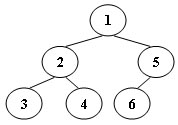03-树3 Tree Traversals Again (25分)
题目描述
An inorder binary tree traversal can be implemented in a non-recursive way with a stack. For example, suppose that when a 6-node binary tree (with the keys numbered from 1 to 6) is traversed, the stack operations are: push(1); push(2); push(3); pop(); pop(); push(4); pop(); pop(); push(5); push(6); pop(); pop(). Then a unique binary tree (shown in Figure 1) can be generated from this sequence of operations. Your task is to give the postorder traversal sequence of this tree.

Input Specification:
Each input file contains one test case. For each case, the first line contains a positive integer N (≤30) which is the total number of nodes in a tree (and hence the nodes are numbered from 1 to N). Then 2N lines follow, each describes a stack operation in the format: "Push X" where X is the index of the node being pushed onto the stack; or "Pop" meaning to pop one node from the stack.
Output Specification:
For each test case, print the postorder traversal sequence of the corresponding tree in one line. A solution is guaranteed to exist. All the numbers must be separated by exactly one space, and there must be no extra space at the end of the line.
Sample Input:
6
Push 1
Push 2
Push 3
Pop
Pop
Push 4
Pop
Pop
Push 5
Push 6
Pop
Pop
Sample Output:
3 4 2 6 5 1
解题思路
通过观察Push和Pop的顺序可以发现,Push的顺序和先序遍历一样,Pop的顺序和中序遍历一样。因此可以先通过两个数组分别存储先序遍历序列和中序遍历序列,再通过这两个数组构建二叉树,最后再后序遍历即可。
代码
#include <stdio.h>
#include <stdlib.h>
#include <string.h>
#define MAXSIZE 30
struct StackNode {
int data;
struct StackNode *next;
};
typedef struct StackNode *Stack;
Stack createStack() {
Stack stack = (Stack) malloc(sizeof(struct StackNode));
stack->next = NULL;
return stack;
}
void push(Stack stack, int data) {
Stack node = createStack();
node->data = data;
node->next = stack->next;
stack->next = node;
}
int pop(Stack stack) {
if (!stack->next) return -1;
Stack top = stack->next;
int data = top->data;
stack->next = top->next;
free(top);
return data;
}
struct TreeNode {
int data;
struct TreeNode *left;
struct TreeNode *right;
};
typedef struct TreeNode *Tree;
int n, num = 0;
int preOrder[MAXSIZE], inOrder[MAXSIZE];
Tree createTree(int preL, int preR, int inL, int inR) {
if (preL > preR) return NULL;
Tree root = (Tree) malloc(sizeof(struct TreeNode));
root->data = preOrder[preL];
int rootIndex = inL;
for ( ; rootIndex <= inR; rootIndex++) {
if (preOrder[preL] == inOrder[rootIndex]) break;
}
int leftNums = rootIndex - inL;
root->left = createTree(preL + 1, preL + leftNums, inL, rootIndex - 1);
root->right = createTree(preL + leftNums + 1, preR, rootIndex + 1, inR);
return root;
}
void postOrder(Tree root) {
if (root == NULL) return;
postOrder(root->left);
postOrder(root->right);
printf("%d", root->data);
num++;
if (num < n) printf(" ");
}
int main() {
scanf("%d\n", &n);
Stack stack = createStack();
char input[5];
int data, preIndex = 0, inIndex = 0;
for (int i = 0; i < 2 * n; i++) {
scanf("%s", input);
if (strcmp(input, "Push") == 0) {
scanf("%d\n", &data);
push(stack, data);
preOrder[preIndex++] = data;
} else {
inOrder[inIndex++] = pop(stack);
}
}
Tree root = createTree(0, n - 1, 0, n - 1);
postOrder(root);
return 0;
}





